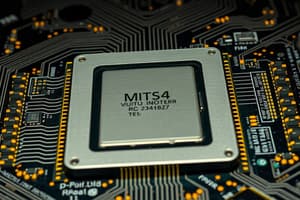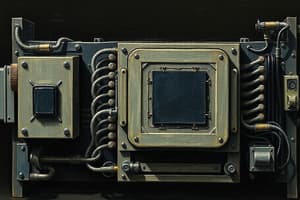Podcast
Questions and Answers
What is the primary function of the Arithmetic and Logic Unit (ALU)?
What is the primary function of the Arithmetic and Logic Unit (ALU)?
- To provide storage internal to the CPU
- To perform the computer's data processing functions (correct)
- To sequence the logic of the computer's operation
- To control the operation of the CPU and hence the computer
What is the role of the Control Unit in the CPU?
What is the role of the Control Unit in the CPU?
- To perform data processing functions
- To sequence the logic of the computer's operation
- To provide storage internal to the CPU
- To control the operation of the CPU and hence the computer (correct)
What is the function of the Registers in the CPU?
What is the function of the Registers in the CPU?
- To provide storage internal to the CPU (correct)
- To sequence the logic of the computer's operation
- To control the operation of the CPU and hence the computer
- To perform data processing functions
What is the purpose of the Instruction Register (IR)?
What is the purpose of the Instruction Register (IR)?
What occurs during the Fetch Cycle?
What occurs during the Fetch Cycle?
What is the purpose of the Program Counter (PC)?
What is the purpose of the Program Counter (PC)?
What type of interrupt occurs when an I/O controller requests service from the processor?
What type of interrupt occurs when an I/O controller requests service from the processor?
What is the purpose of the CPU interconnection?
What is the purpose of the CPU interconnection?
What is the purpose of the Memory Address Register (MAR)?
What is the purpose of the Memory Address Register (MAR)?
What happens when the Interrupt Cycle is triggered?
What happens when the Interrupt Cycle is triggered?
What is the purpose of the Instruction Register (IR)?
What is the purpose of the Instruction Register (IR)?
What is the difference between Direct and Indirect Addressing modes?
What is the difference between Direct and Indirect Addressing modes?
What is the purpose of the Program Counter (PC)?
What is the purpose of the Program Counter (PC)?
What happens during the Fetch Cycle?
What happens during the Fetch Cycle?
What is the purpose of the Memory Buffer Register (MBR)?
What is the purpose of the Memory Buffer Register (MBR)?
What is the difference between Computer Instructions and I/O Instructions?
What is the difference between Computer Instructions and I/O Instructions?
Flashcards are hidden until you start studying
Study Notes
Computer Structure
- The computer structure consists of four main components: Main Memory, I/O devices, System BUS, and CPU
- CPU consists of ALU, Internal BUS, Registers, and Control Unit
- Control Unit controls the operation of the CPU and hence the computer
- Arithmetic and logic unit (ALU) performs the computer's data processing functions
- Registers provide storage internal to the CPU
- CPU interconnection provides communication among the control unit, ALU, and registers
Creating a Program
- A program is a sequence of steps
- Instruction Interpreter: a device that accepts instruction codes and turns them into control signals for the arithmetic and logic hardware
- Encoding Instructions: unique binary patterns identify the operation to be performed
CPU Operations
- Fetch Cycle: Processor fetches an instruction from memory location pointed to by the Program Counter (PC)
- PC holds the address of the next instruction to fetch
- Instruction loaded into the Instruction Register (IR)
- Processor interprets the instruction and performs required actions
Execution Cycle
- Execute Cycle: the processor performs the required actions based on the instruction
- Processor-memory: data transfer between CPU and main memory
- Processor-I/O: data transfer between CPU and I/O module
- Data processing: some arithmetic or logical operation on data
- Control: alteration of sequence of operations, e.g., jump
Interrupts
- Types of Interrupts:
- Program: "illegal instructions" (arithmetic overflow, divide by zero, or memory handling error)
- Timer: "processor can perform some time-scheduled task"
- I/O: "generated by an I/O controller to request service from the processor" (e.g., keyboard, mouse, NIC, disk drive)
- Hardware failure: "signifies some error condition with the hardware"
Instruction Cycle
- Calculate Address Instruction
- Instruction Fetch
- Decode instruction
- Calculate operand address
- Fetch operand
- Operand operation
- Operand address calculation
- Operand store
- Check interrupt
I/O Modules
- Transfer data back and forth with the device as if it were memory
- Alternatively, the processor can grant the I/O module permission to write directly to memory - Direct Memory Access (DMA)
- Interrupt occurs when DMA is complete
Registers
- Program Counter (PC): holds the address of the next instruction
- Memory Address Register (MAR): connected to the address bus, specific address for read and write operation
- Memory Buffer Register (MBR): connected to the data bus, specific data to read or write last data
- Instruction Register (IR): holds the instruction after fetch
Micro-operations
- Transfer data between registers
- Transfer data from register to external
- Transfer data from external to register
- Perform arithmetic or logical operations
Flowchart of Instruction Cycle
- Fetch Cycle:
- T1: MAR <- PC
- T2: MBR <- Memory[PC]
- T3: IR <- MBR
- Indirect Cycle:
- T1: MAR <- IR
- T2: MBR <- Memory
- T3: IR <- MBR
- Interrupt Cycle:
- T1: MBR <- PC
- T2: MAR <- Saved Address
- T2: Memory <- MBR
Addressing Modes
- Direct Addressing (MODE 0): the instruction code specifies the address of an operand
- Indirect Addressing (MODE 1): the bits of the second part of the instruction designate an address of a memory word in which the address of the operand is found
Studying That Suits You
Use AI to generate personalized quizzes and flashcards to suit your learning preferences.




